Introduction
Scientific and technological breakthroughs have propelled dentistry into a new era, empowering clinicians to better diagnose and address oral health issues. This ongoing digital evolution marks a golden age in dentistry, offering:
- Tools that aid or support diagnosis
- More diverse treatment options
- Improved treatment planning (no predictability)
- Significantly enhanced clinical outcomes
- Customised patient experiences.
The synergy between technology and education revolutionises dentistry. Interactive technology also plays a pivotal role as an educational tool, elevating the quality of patient communication with unparalleled visual precision.
Dental practitioners can convey complex clinical information more comprehensibly and tangibly engage patients. This enhances patient-clinician communication, promotes prevention of oral health issues and informed decision-making and ultimately improves health outcomes. These technologies empower patients to participate in their dental journey, fostering a deeper understanding of their conditions and treatment options.
Among the many advancements, the intraoral scanner has emerged as a game-changer. It has redefined impression-taking and treatment planning, facilitated a safer, more precise delivery of countless dental procedures and enhanced patient comfort and treatment results.
Intraoral scanners have taken case visualisation, both by professionals and patients, to the next level for communication, diagnosis, treatment planning and case documentation purposes.
Streamlining workflows with intraoral scanners has proven invaluable for clinicians looking to optimise practice workflows. Investing in an intraoral scanner offers many opportunities for practitioners to grow their practice.
Unlocking potential: The impact of intraoral scanners
Intraoral scanners have become indispensable tools for modern dental practices, revolutionising how practitioners capture accurate impressions and plan treatments. But how does an intraoral scanner work?
An intraoral scanner employs cutting-edge optical technology to generate precise 3D images of the oral cavity. It utilises structured light, or laser technology, to capture intricate details of the teeth and surrounding tissues. These scanners emit light onto the teeth, detecting processed reflections to produce digital impressions.
With real-time feedback and high-resolution imaging, an intraoral scanner has transformed the conventional dental impression process.
In dental practice, intraoral scanners offer many applications – from diagnosis and treatment planning to restorative dentistry and orthodontics.
Crown and bridge fabrication
Intraoral scanners seamlessly integrate with CAD/CAM systems, simplifying the process of creating dental restorations like crowns and bridges. By eliminating physical impressions, they accelerate the digital workflow, leading to quicker turnaround times for prosthetic creation while ensuring precise fit and optimal aesthetics.
Invisalign system treatment planning
By creating detailed 3D dentition models, intraoral scanners streamline Invisalign treatment planning, facilitating the development of personalised strategies for aligning teeth effectively. A peer-reviewed study, published by The Journal of Clinical Dentistry, confirms the introduction of iTero digital scanning with Invisalign treatment increases case volume and drives practice growth.
Implant dentistry
Intraoral scanners provide high-resolution images of the oral anatomy, aiding in precise surgery planning and implant placement, as well as enhancing the monitoring of long-term stability and function.
Digital treatment planning
With comprehensive images of the patient’s smile, intraoral scanners empower clinicians to make precise adjustments to tooth proportions and contours, offering endless possibilities for customised smile makeovers digitally.
Periodontal assessment
Intraoral scanners offer detailed visualisations of gingival health and tissue contours, aiding periodontists and dental hygienists in accurately diagnosing and monitoring gum diseases and tracking treatment progress effectively.
Caries detection
The iTero NIRI technology (Near Infra-Red Imaging) is a state-of-the-art dental diagnostic tool that aids the detection of interproximal cavities using near-infrared imaging, avoiding ionising radiation used in traditional X-rays. It can distinguish between healthy tooth enamel and decay, providing real-time images for immediate clinical decisions.
Patient-focused dentistry and the intraoral scanner
There are numerous advantages to investing in an intraoral scanner, now widely considered a cornerstone technology for any contemporary dental practice. The internet has revolutionised how we access and disseminate information across all fields, and dentistry is no exception. As our understanding of the latest digital advancements in dental technology expands, so do the expectations of patients with access to online resources empowering patient choice.
Patients are increasingly accustomed to digital technologies in various aspects of their lives and expect the same level of convenience and efficiency in healthcare. They are far more likely to attend a practice that delivers a safe and comfortable dental treatment experience – and is prepared to invest in the cutting-edge technology required to do so.
Indeed, according to the paper ‘Influence of the use of social media on patients changing dental practice: a web-based questionnaire study,’ ‘facilities and technology’ were the most valued factors in their decision to choose a dental practice.
In an increasingly digitalised healthcare arena with a more informed patient base, the onus is on clinicians to stay abreast of the digital revolution and adopt digital workflows. So, what are the advantages of making the investment?
Patient convenience and preference
An intraoral scanner enhances the patient experience, reducing time spent in the chair. Traditional impression-taking methods are notoriously uncomfortable for patients. The intrusive nature of alginate moulds and trays can lead to anxiety and unease, particularly for those with gag reflexes. For the practitioner, there can be a risk of distortion and inaccuracy.
Real-time visualisation and patient engagement
Intraoral scanners enable practitioners to visually demonstrate treatment journeys directly on screen, enhancing patient engagement and understanding. Through successive scans, patients witness the evolution of their dentition over time. This creates opportunities for informed discussions and treatment planning. This visual aid enhances patient understanding and strengthens the practitioner-patient relationship, bolstering trust and confidence in the proposed treatment pathway.
Enhanced collaboration with laboratories
Efficient partnership with dental laboratories is paramount for timely and effective treatment delivery. Intraoral scanners facilitate seamless communication by immediately transmitting digital impressions to the lab. This direct link streamlines workflows, reducing turnaround times for digital cases and eliminating the need for re-impression appointments.
By fostering a symbiotic relationship between practitioners and laboratories, intraoral scanners optimise efficiency and enhance the overall quality of patient care. The iTero-exocad Connector, for example, seamlessly integrates iTero intraoral scanners with exocad Dental CAD software, reducing errors and streamlining treatment planning. Such collaboration promotes better communication among dental professionals and offers patients a more personalised and engaging experience.
Cost-saving, space-saving, and planet-saving
Adopting intraoral scanners translates into tangible cost savings for dental practices. Digital scanning eliminates the need for physical materials used in traditional impression methods, such as impression trays and materials. It also eradicates associated labour costs for impression-taking and shipping.
Digital impressions can be instantly transmitted to the chosen lab, expediting the treatment process and enhancing patient satisfaction – as today’s consumers don’t want to wait! And, with intraoral scanners, study models are no longer physically stored. By digitising the model archive, practices can free up much-needed space.
Reducing material usage conserves financial resources and contributes to environmental sustainability – by helping to decrease the practice’s carbon footprint by eliminating the shipment of patients’ PVS impressions – aligning with the ethos of responsible healthcare provision.
Marketing advantages
By marketing yourself as a digitalised practice, you can attract new patients while retaining existing ones, distinguishing your practice from competitors.
Empowering time management and team efficiency
Intraoral scanners help to optimise time management and workflow efficiency. Through targeted training initiatives, dental nurses and other practice team members can proficiently scan patients, freeing practitioners to focus on core clinical activities.
Task delegation maximises resource use and cultivates a cohesive team dynamic within the practice setting. Digital tools also facilitate communication and collaboration among dental professionals, allowing them to share patient records, images and treatment plans more easily. This interdisciplinary approach can lead to more comprehensive care and better patient outcomes.
Incorporating intraoral scanners also promotes ongoing learning and professional development. Training to use intraoral scanners enables dental professionals to gain new skills and broaden their expertise, leading to satisfaction and growth.
The authors of the paper, 3D Digital Impression Systems Compared with Traditional Techniques in Dentistry: A Recent Data Systematic Review, recommend the use of an intraoral scanner, which, ‘from the formation of a virtual image creates an accurate physical model that gives efficiency to the dental structure and makes the work lighter. This improved way of working should benefit the dentist, the laboratory and the patient’.
By embracing the digital revolution in dentistry, clinicians can take control of their practice’s future.
As the industry continues to evolve, staying ahead of technological advancements can ensure the practice remains competitive in the long term, empowering clinicians to shape their own success.
What to look for in an intraoral scanner
Selecting the ideal intraoral scanner amidst many brands and models, requires careful evaluation and consideration.
As a practice owner, you need to:
- Assess your specific needs and workflow requirements
- Consider factors such as the volume of scans you’ll be performing
- Think about who will be performing the scans in your practice(s)
- Think about the types of procedures you commonly handle
- Look at the level of integration you seek with other dental technologies, laboratories and software systems
- Look for the level of service you would expect
- Future proof your choice of scanner.
Future proof
A recent review suggests that ‘the results of the studies analysed encourage the idea that, in the near future, also thanks to further technological innovations, there is the possibility of using intraoral scanners as diagnostic devices in clinical practice, providing quantitative parameters on which to base clinical decision-making, with advantages for both the clinician and the patient.’
The iTero NIRI technology Near Infra-Red Imaging is a cutting-edge advancement already being used to support dental diagnostics. The system aids in detecting interproximal caries without ionising radiation, commonly associated with traditional bitewing X-rays. It empowers clinicians with real-time imaging, allowing them to see the scanned images immediately and make quick clinical decisions. This immediate feedback can aid in treatment planning and patient education.
Given the abundance of choices in today’s market and the ongoing advancements in intraoral scanner technology, dental practitioners must clearly understand the key factors to consider when choosing the best intraoral scanner for their practice.
Investing in the best intraoral scanner for your practice will enhance clinical outcomes and patient satisfaction and position you as a key player in the digital age of dentistry.
Here are some key factors to consider to ensure you make an informed decision:
Accuracy
Precision directly influences the quality of restorations and treatment results. An intraoral scanner with high accuracy ratings guarantees that the digital models best reflect the patient’s oral anatomy, ensuring reliable outcomes.
Speed
An intraoral scanner that offers fast scanning speeds without compromising the all-important accuracy is essential. A scanner with rapid data acquisition capabilities can significantly improve workflow efficiency and patient throughout.
Ease of use
User-friendliness is essential, especially for practitioners who may not have extensive experience with digital technologies. An intuitive interface and straightforward workflow can streamline the scanning process and minimise the learning curve.
Reliability
The long-term return on investment is crucial to this decision-making process. Durability, reliability and continuity provisions are also vital. Evaluating the intraoral scanner’s scalability and integration capabilities into existing workflows is imperative for making informed decisions. It is also important to look at the service plan and ongoing support provided to ensure peace of mind.
Integration with existing workflows
Seamless integration with your existing digital workflows is crucial for maximising efficiency and minimising disruption to your practice. Ensure the scanner is compatible with your current software systems, such as CAD/CAM and practice management systems, or consider companies that offer an integrated digital platform, such as the Align™ Digital Platform, that ensures a seamless patient journey.
Training and education
ntegrating an intraoral scanner into existing practice workflows can be complex, especially if it involves connecting with other software or systems. Proper education and support can help dental professionals navigate this process smoothly, ensuring seamless integration and minimal disruption to daily operations.
Access to comprehensive education and support can help practices maximise their return on investment (ROI) by fully utilising the intraoral scanner’s capabilities and achieving optimal outcomes for patient care and practice efficiency.
Continuous education ensures that dental professionals stay updated on the latest advancements, best practices and techniques related to intraoral scanning so they can maximise the functionality of the scanner, fully understand its features and integrate it seamlessly into practice workflows.
This ongoing learning process is essential for maintaining high standards of patient care, staying competitive in the field, and adapting to evolving industry trends.
Technical support
Like any technology, intraoral scanners may encounter technical issues or require maintenance over time. Access to reliable technical support is essential to address any problems promptly and minimise downtime. Without adequate support channels, practices may experience prolonged periods of disruption, affecting patient care and practice operations.
Software
The software accompanying the intraoral scanner plays a vital role in data processing, visualisation and communication. Look for robust software with advanced features such as real-time feedback, cloud storage and compatibility with third-party applications. It is also essential to consider the availability of automatic software updates and technical support.
Brands and models of intraoral scanners
Having established that intraoral scanners are essential tools in modern dentistry, we explore the brands and models available on the market to help you make an informed decision when selecting the right device for your practice.
Intraoral scanners come in various types, each with its own unique features and capabilities, to enable precise digital impressions for different dental procedures.
Align
Align’s iTero intraoral scanners are designed to deliver speed, reliability, intuitive operations and outstanding visualisation capabilities for general practitioners and orthodontists iTero scans have been used in more than 16 million restorations, from crowns and bridges, implants to dentures (Data on file at Align Technology, as of June 30, 2022).
iTero intraoral scanners capture detailed 3D images of a patient’s oral structures, seamlessly integrating them into the Align Oral Health Suite. This advanced software platform gathers oral health conditions into one oral health assessment model to provide a full review to the patients with easy-to-understand, engaging visualisations.
It helps patients understand their current status, trust the clinician’s diagnosis, and understand the proposed treatments. It also includes in-face simulations of the patient’s future smile that’s proven to drive treatment acceptance. The Suite is then an oral health assessment and conversion tool.
Process
Step 1: Scan your patient – create digital impressions in minutes
Step 2: Diagnose and educate – share your diagnosis and treatment plans with patients to increase case acceptance
Step 3: Send scans to partners in minutes [1] or directly use for in-practice fabrication
Step 4: Receive feedback – adjust as needed and start treatment earlier
Step 5: Begin treatment and monitor progress – on with the treatment. Keep your patients engaged by sharing progress with them at every visit.
iTero Lumina scanner
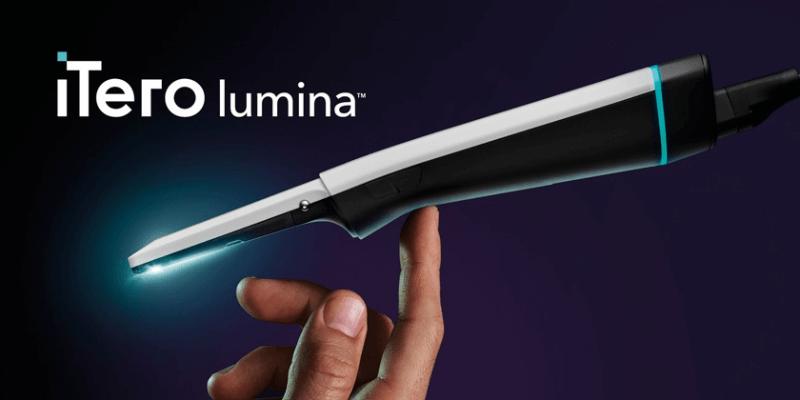
Align Technology’s latest cutting-edge development
Launched in 2024, the iTero Lumina scanner represents a revolutionary advancement in intraoral scanning technology. It offers clinicians unprecedented capabilities and ease of use, ultimately enhancing patient care and practice efficiency.
With its faster scan times, increased accuracy and improved ergonomics, the iTero Lumina scanner is designed to make work easier and more efficient, leading to better patient outcomes.
The iTero Lumina scanner pushes the boundaries of what intraoral scanners can do thanks to iTero Multi-Direct Capture (MDC) technology.
With a lighter and smaller design than its predecessors, the iTero Lumina scanner’s enhanced capabilities include:
- Three times larger field of capture
- A capture distance of up to 25mm
- A 50% smaller and 45% lighter scan wand.
The iTero Lumina scanner is adept at capturing detailed images, rivalling intraoral photography and facilitating better patient communication.
A standout feature of the iTero Lumina scanner is its ability to effectively capture large edentulous spans and intricate palate detail, which is a significant advancement. The scanner employs ‘multi-direct capture’ technology, utilising multiple cameras to capture from various angles simultaneously, allowing for uninterrupted scanning of more dentition in a single movement.
iTero Element 5D imaging system
Whether you’re making the leap to a digital workflow or looking to upgrade, the iTero Element 5D imaging system is a great investment to help you provide the best possible care to your patients. Built for ease of use, it’s the first hybrid dental imaging system that simultaneously records 3D, intraoral colour and near-infrared images (NIRI) – eliminating the need for multiple devices and repetitive sterilisation.
NIRI, which is non-invasive by nature, can be used as frequently as required to monitor the patient’s oral health and provide chairside education. It has been demonstrated to be an effective tool in aiding the diagnosis and monitoring of early stages of interproximal caries above the gingiva in a wide array of clinical scenarios, ultimately leading to the successful management of caries even in its earliest stages.
This enables patients to appreciate and understand the finer details associated with their oral health. A clinical guide by Dr Priyanka Keshav introducing the iTero Element 5D imaging system, highlights its NIRI technology’s ability to aid in the detection and monitoring of interproximal caries lesions without radiation exposure.
Clinical case presentations demonstrate the system’s efficacy in identifying caries lesions and existing restorations. Despite limitations around existing restorations, NIRI emerges as a valuable tool for early caries detection, supporting minimally invasive dental practices.
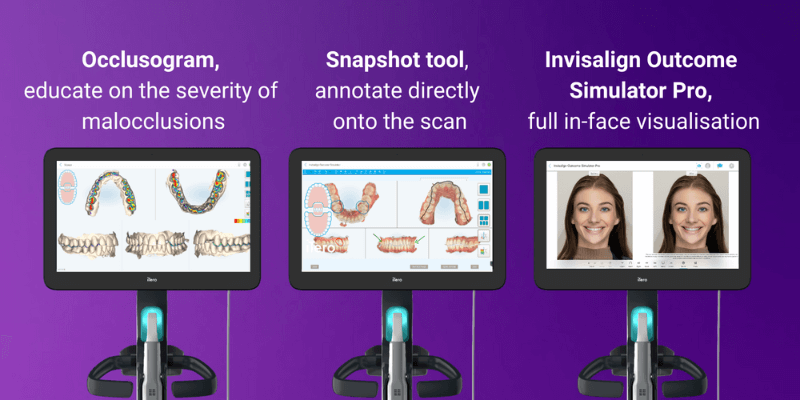
Additionally, with iTero TimeLapse technology, you can keep your patients engaged by helping them visualise diagnostic, restorative, or orthodontic comparisons.
Its parallel confocal imaging technology uses optical and laser scanning for accurate colour scans. iTero Element scans are engineered to work with the Invisalign system, the exclusive Invisalign Outcome Simulator, and the Progress Assessment tool.
It also connects to restorative and orthodontic labs, third-party treatment planning, custom implant abutments, chairside milling, and lab CAD/CAM systems.
The iTero Element scanner delivers speed, reliability, intuitive operations, and outstanding visualisation capabilities, all in a compact footprint. With the iTero Element, full arch scans can take as little as 60 seconds, saving time and improving patient experiences.
Engineered to be portable, powerful, and intuitive, it is a digital innovation transforming practices worldwide. The iTero scanner empowers you to visualise a better practice.
The iTero Element 5D imaging system is an innovation designed to make comprehensive dentistry a reality in every dental practice.
What it offers:
- 3D digital impressions – crisp intraoral scanning. Treatment simulation. And more, without harmful radiation. [1]
- Advanced technology to scan internal tooth structure – the first 3D intraoral scanner with iTero NIRI technology aids diagnostic workflows. It detects and monitors interproximal caries above the gingiva in real-time.
- Get patients excited about what their new smiles could look like – the Invisalign Outcome Simulator keeps patients engaged and treatments on track. [2]
- Show your patients how their treatment is progressing with iTero TimeLapse technology – when patients can see their changes over time, they’re more likely to stay engaged and take better care of their oral health. This helps monitor treatment progress for better outcomes.
- Work more efficiently – engage with your lab by sending restorative STL files directly to it or exporting them from your iTero cloud account.
iTero Element 5D Plus
iTero Element 5D Plus imaging system offers cutting-edge digital scanning performance that delivers a seamless experience. iTero Element 5D Plus imaging system is built upon the success of the iTero Element portfolio, which features innovative technology like iTero Near Infra-Red (NIRI) Technology to aid in caries detection above the gingiva. Take your practice to the next level with enhanced productivity and patient experiences.
iTero Element Flex scanner
With the iTero Element Flex, you have the ultimate mobility, allowing you to provide dedicated care wherever you see patients. The wand-only configuration puts the power of iTero Element technology in your hands to perform full arch scans in even the smallest office.
What the professionals say…
You can find out more about the iTero intraoral scanner range on their website
3Shape
3Shape Trios offers a range of intraoral scanners designed for dental professionals. These scanners are known for their advanced technology, user-friendly interface, and compatibility with various dental workflows, making them popular among dental professionals seeking to enhance their digital dentistry capabilities.
3Shape Trios 4
This is the latest model in the Trios line-up, boasting enhanced scanning speed, accuracy, and colour capture capabilities. It offers high-definition, lifelike colour scanning, making it ideal for capturing natural tooth shades and textures. It also features real-time scanning feedback to ensure optimal results.
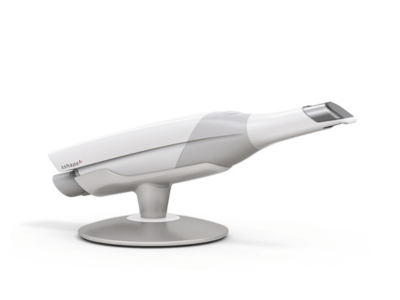
3Shape Trios 3
The Trios 3 scanner offers fast and accurate intraoral scanning, enabling digital impressions for dental applications. It’s known for its ergonomic design and intuitive software interface, allowing for efficient chairside scanning. The Trios 3 is compatible with many restorative materials and workflows.
3Shape Trios 3 Basic
This model offers essential scanning capabilities at a more affordable price point. It provides accurate digital impressions for basic restorative procedures, making it suitable for smaller dental practices or those looking to adopt digital dentistry without a significant investment.
3Shape Trios 3 Wireless
This version of the Trios 3 scanner offers the convenience of wireless operation, allowing for greater mobility and flexibility during intraoral scanning procedures. It maintains the same high level of accuracy and efficiency as the wired version but with the added benefit of eliminating cables and improving manoeuvrability.
Carestream
CS 3600 intraoral scanner is a versatile solution tailored to meet the specific demands of dental practices. Whether you’re dealing with restorative, orthodontic, or implant cases, the CS 3600 streamlines the process of capturing digital impressions, providing a smarter scanning experience.
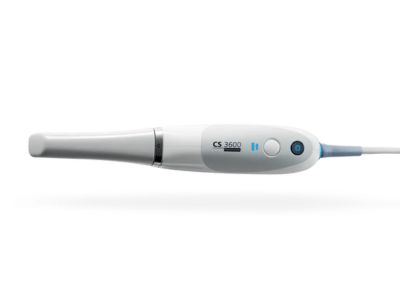
Key features and benefits include:
- High-speed continuous scanning – offers a quick, seamless, and efficient user experience
- Intelligent Matching System – enables the completion of missing data in any area, enhancing flexibility
- Scan data history – allows for the removal of excess scanned tissue, refining the final digital impression
- Wide range of applications – dedicated workflows for restorations, orthodontics, and implant-borne restorations accommodate various dental needs
- Intuitive user interface – guided step-by-step processes simplify the transition to a digital workflow
- Autoclavable, reusable tips – two interchangeable styles optimise ergonomics and flexibility
- Precise 3D HD colour scanning – ensures accurate and high-quality image output
- Open system scanning – this provides flexibility with open .stl and .ply file outputs and offers compatibility with different software and systems.
Dentsply Sirona
CEREC Primescan Connect
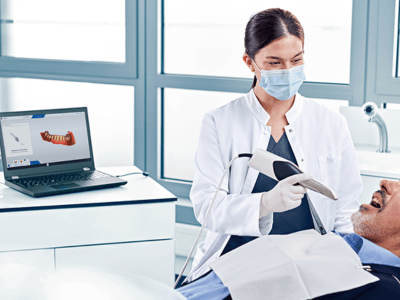
CEREC Primescan Connect is a high-performing intraoral scanner now available in a laptop configuration. It allows you to perform high-precision digital impressions of the patient’s mouth without using traditional impression material. With simplified scanning and streamlined workflows, Primescan Connect is a great starting point for digital dentistry. With it, you can achieve better diagnostics, treatment planning, and accelerated financial growth while improving the patient experience.
- Speed – a full arch scan is possible in less than a minute
- Ease of use – helps to simplify the scanning process, so you can delegate the impression-taking process to your team and spend more time with patients
- Accuracy – excellent scans, no matter which material or the difficulty of capturing the area
- Flexibility – takes up little space and is easy to integrate into your practice workflows and set-up.
Dexis
DEXIS offers a range of intraoral scanners designed to revolutionise how clinicians capture digital impressions. Each offers unique features tailored to meet the diverse needs of dental professionals.
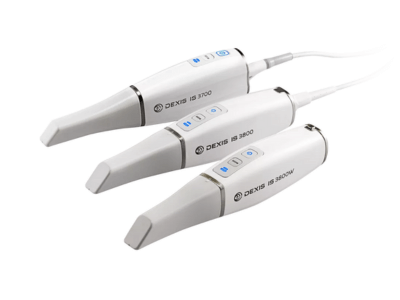
DEXIS IS 3600
DEXIS IS 3600 is equipped with advanced technology to provide crystal-clear images, enhancing diagnostic capabilities while ensuring patient comfort. Its ergonomic design and intuitive software make it easy to operate, streamlining the scanning process and improving workflow efficiency.
DEXIS IS 3700
DEXIS IS 3700 introduces enhanced scanning speed and accuracy. Improved image resolution and depth perception enable Clinicians to capture detailed impressions quickly and accurately. Its enhanced ergonomic features ensure optimal patient comfort during scanning, improving the overall patient experience.
DEXIS IS 3800
DEXIS IS 3800 takes intraoral scanning to the next level with its cutting-edge features and capabilities. Designed to deliver unparalleled accuracy and efficiency, it incorporates advanced technology to capture precise digital impressions in a fraction of the time compared to traditional methods.
Its ergonomic design and user-friendly interface make it ideal for busy dental practices seeking to optimise their workflow.
DEXIS IS 3800W
DEXIS IS 3800W is ideal for dental practices that value wireless convenience. It offers the same exceptional performance as the IS 3800 but with the added flexibility of wireless connectivity. This feature allows for greater freedom of movement during scanning without compromising image quality or accuracy.
Eighteeth
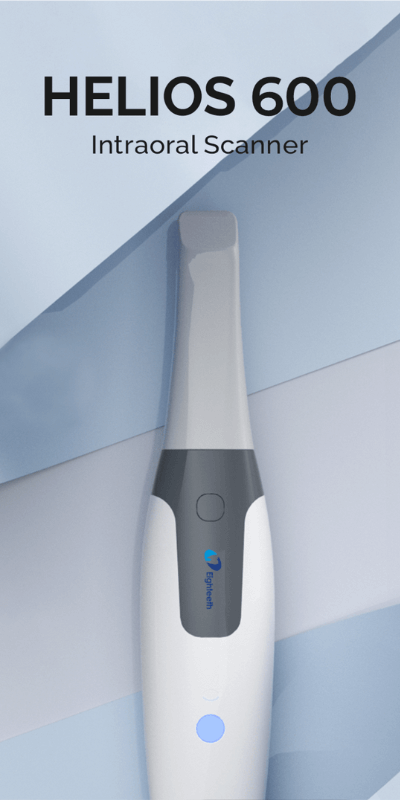
Helios 600 model
Helios 600 model boasts high accuracy achieved through automatic and adaptive calibration, eliminating the need for manual calibration. Despite its compact size, it offers a high-definition field of view measuring 16mm x 14mm, making it suitable for various dental applications.
Its lightweight design – at 198 grams – makes it one of the most portable and ergonomic scanners available. It also excels in speed, capturing a full arch scan in less than 30 seconds, enhancing efficiency for dental professionals.
Integrating AI technology enhances the scanning process by filtering soft and moving tissues, resulting in smoother scans and natural-looking treatment outcomes.
The Helios 600 has an average deviation of around 20μm in in-vivo full arch scans. The Plug & Scan feature emphasises its ease of use, allowing users to start scanning within seconds of opening the case.
Additional features include:
- Versatility as an intraoral scanner and camera
- Free automatic software updates
- Cloud storage
- Online 3D viewer
- Air mouse for intuitive navigation
- Voice note functionality
- Smart reminders
- Attitude sensor for improved customer interaction.
The Helios 600 is designed for durability, featuring a firm body design and removable, autoclavable scanner tips in two sizes.
Customers can benefit from timely after-sales service, including UK warranty and support, ensuring continued satisfaction and reliability.
Medit
Medit intraoral scanners each offer unique features and capabilities to meet the diverse needs of dental professionals.
Medit i500
This compact, lightweight intraoral scanner provides fast and accurate scanning. It utilises an open CAD/CAM system, allowing for seamless integration with various dental software and workflows. The i500 offers high-resolution scans and an ergonomic design for ease of use.
Medit i600
Medit i600 is an affordable solution for intraoral scanning. Developed as a successor to the acclaimed i500, the i600 stands out with numerous upgrades across various aspects. Notably, the i600 shares several features with the i700, including the scanner body, optical engine, scanning tips, and cable.
Medit i700
Medit i700 is a step forward from the i500, introducing advanced features such as artificial intelligence-driven scanning capabilities. It’s faster, more accurate, and more efficient, making it suitable for various dental applications, from restorative dentistry to orthodontics.

Medit i700 wireless
Make your scanning comfortable no matter the angle. This is the same light, accurate and fast scanner as the i700, but now wireless. Effortlessly scan at up to 70 frames per second and enjoy an amazingly smooth and fast scan. The Medit i700w has a continuous scanning time of up to one hour and three rechargeable batteries.
Medit T-Series
The T-Series includes models such as the T310 and T510, offering versatility and precision in intraoral scanning. These scanners feature high-speed scanning, autoclavable tips for optimal hygiene, and compatibility with various CAD/CAM systems. The T-Series is designed to streamline the digital workflow in dental practices.
Planmeca
Planmeca Emerald S
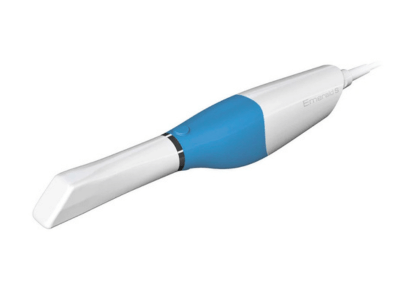
The compact and ergonomic Planmeca Emerald S intraoral scanner offers a smooth and comfortable scanning experience for you and your patients. The scanner captures digital impressions efficiently, allowing a capable user to capture a full arch in under a minute.
Completed scans are stored in the Planmeca Romexis software and immediately available for further use.
Straumann
Virtuo Vivo
Virtuo Vivo intraoral scanner boasts several key features that enhance its usability and performance:
- Flexibility – it employs an open system, allowing users to export and share scan data with dental partner labs and preferred services, fostering seamless collaboration.
- Simplicity – guided workflow assists users at every step, facilitating easy access to services through integrated connectivity and simplifying the scanning process.
- High resolution – the scanner offers high-resolution colour scanning, enabling better patient communication. It captures teeth and soft tissue from multiple angles simultaneously, including hard-to-reach areas, with minimal effort.
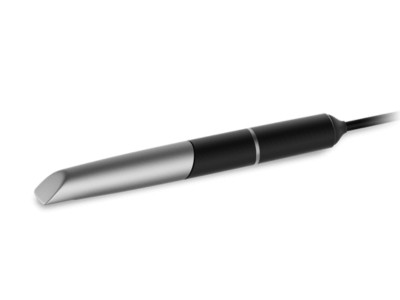
- Speed – equipped with advanced 3D scanning technology, it captures data from multiple angles simultaneously, essentially integrating the power of two miniaturised 3D scanners into a compact, handheld device, thereby enhancing efficiency.
- Precision – the software generates the 3D model, facilitating real-time data quality validation. A luminescent ring on the handpiece and audible signals indicate successful scan data capture, ensuring accuracy.
- Hygiene – to maintain proper patient hygiene, the scanner features a removable, autoclavable sleeve made of coated metal. This safeguards against contamination and promotes patient safety.
Vatech
Vatech intraoral scanner
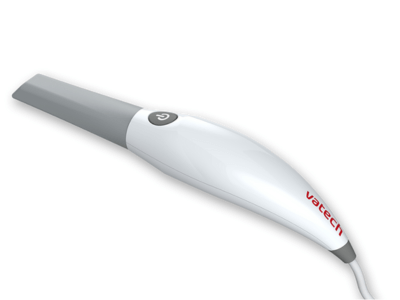
Vatech intraoral scanner offers dentists a powerful tool for capturing detailed 3D images of the oral cavity, facilitating accurate diagnoses and treatment planning while enhancing the overall patient experience.
- High-resolution imaging – the scanner utilises advanced technology to capture high-resolution 3D images, providing detailed views of the teeth, gums, and other oral structures.
- Comfortable for patients – the intraoral scanner is designed to be comfortable for patients, minimising discomfort and allowing for quick and efficient image capture.
- Fast scanning – with rapid scanning capabilities, the Vatech intraoral scanner enables dentists to capture images quickly, saving time for both the patient and the dental practice.
- Accurate results – the scanner delivers accurate 3D images, helping dentists make precise diagnoses and treatment plans.
- Enhanced patient communication – the detailed images produced by the scanner can be easily shared with patients, improving communication and helping them better understand their oral health needs.
- Integration with dental software – the Vatech intraoral scanner is often compatible with various dental software systems, allowing seamless integration into existing practice workflows.
Integrating intraoral scanners into your practice
Successfully incorporating intraoral scanners into your dental practice requires careful planning and implementation. To support a seamless integration – and maximise efficiency and effectiveness – some key areas need to be addressed.
Although intraoral scanning presents numerous advantages, such as heightened efficiency, convenience and improved communication with both laboratories and patients, its practical implementation hinges on adequate education and training.
Proper training in intraoral scanners enhances dental practice efficiency by enabling quick and accurate digital impressions, reducing patient chair time.
Staff proficiency ensures precise image capture, minimising the need for retakes and enhancing the quality of care. Patients also benefit from a more comfortable experience, as trained staff can navigate scanning procedures with finesse, alleviating discomfort associated with traditional methods.
Continuous education keeps staff updated on evolving technology, facilitating seamless integration into practice workflows. It also equips them to troubleshoot issues and educate patients on the advantages of digital dentistry, ultimately leading to long-term cost savings.
There are numerous options when it comes to training and staff support.
Some manufacturers offer comprehensive training programmes for purchasing clinicians to learn scanner operation and software use for future education and support. Training can take various forms, including online tutorials, webinars or in-person workshops.
Familiarity with the scanner’s software and capabilities is crucial for establishing best practices, ensuring proper technique and minimising common errors.
Peer collaboration and attending conferences also help practitioners stay updated about any updates or advancements. Proficiency is honed through practice, starting with more straightforward cases and progressing to more complex procedures, where more experienced practitioners can often be called on as mentors.
For example, Align Technology provides extensive education and support resources for dental professionals for its iTero scanners. It has developed a learning journey that offers a pathway to digital adoption and practice growth personalised to your needs.
The organisation’s Foundation programme enhances dental professionals’ knowledge and skills in effectively utilising iTero scanners. It covers scanner features, tools, clinical protocols, and scanning techniques.
The training is delivered by iTero clinical trainers in a virtual classroom setting, allowing participants to learn at their own pace through interactive courses, videos and other instructional support materials.
There are opportunities for further learning and integration through programmes like Mastering iTero, which includes instructor-led sessions in multiple languages and live/on-demand webinars.
These sessions focus on integrating iTero applications into dental practices, optimising clinic workflows and improving patient experiences with the scanner.
iTero offers professional education opportunities through speaker-led webinars, providing peer-to-peer clinical education to support dental professionals’ professional growth and clinical journey. These initiatives are part of Align Technology’s commitment to providing continuous education for healthcare professionals.
A vision of the future for intraoral scanners
The field of intraoral scanning is constantly evolving, with ongoing advancements and innovations dovetailing perfectly with other global developments within dentistry.
Recent advancements in intraoral scanning technology have led to the development of wireless and portable scanners. These scanners offer greater flexibility and convenience for patients and practitioners, allowing for easier manoeuvrability and improved patient comfort during scanning procedures.
Intraoral scanners already on the market leverage artificial intelligence (AI) and machine learning algorithms to enhance image quality, streamline the scanning process, and improve accuracy. These AI-powered scanners automatically detect and correct errors in the scanning process, leading to more consistent and reliable results.
The future of digital technology, including intraoral scanning, may also likely involve further miniaturisation, improved accuracy and integration with emerging technologies such as augmented reality (AR) and virtual reality (VR).
Devices prioritising comfort, convenience, and ease of use are already being developed, with features such as ergonomic handpieces, non-invasive scanning techniques, and customisable settings that make the scanning process more tolerable. These patient-centric designs also emphasise the importance of clear communication and education, ensuring they understand the benefits of intraoral scanning and feel empowered to participate in their dental care journey.
Additionally, advancements in materials science may lead to the development of intraoral scanners capable of capturing not only the external surfaces of teeth but also detailed information about their internal structures.
This continual evolution is driven by technological advancements, increasing demand for digital solutions in dentistry and a focus on enhancing patient care and improving outcomes.
By placing patients at the centre of design considerations, intraoral scanners can enhance satisfaction levels, foster trust between clinicians and patients, and ultimately improve treatment outcomes.
Your next steps
Before investing in intraoral scanners, clinicians should conduct thorough research and due diligence.
Engaging with peers who have experience using these intraoral scanners provides valuable insights. Online forums can offer additional support and information. Attending dental exhibitions allows direct interaction with manufacturers to compare options.
Evaluating aftersales support, including warranty coverage and technical assistance, is crucial. Look for comprehensive training programmes and troubleshooting resources.
Assess the reliability of the distributor network for timely servicing, and don’t forget to consider the manufacturer’s reputation for innovative design and ongoing commitment to development in dental technology.
Stay updated with relevant information about this webinar
